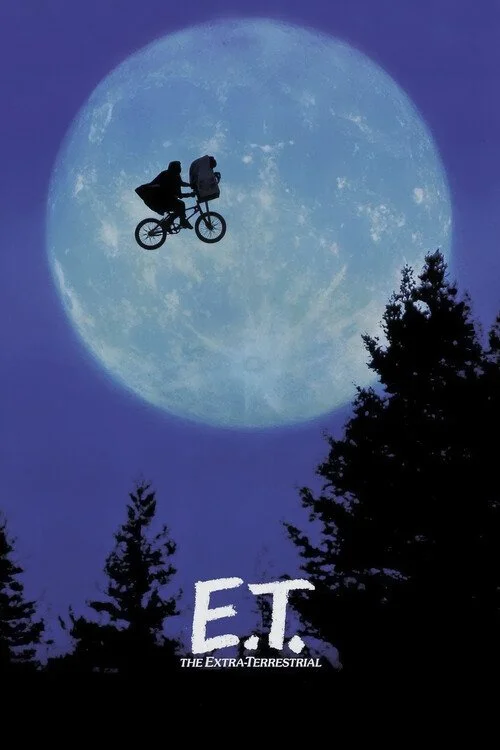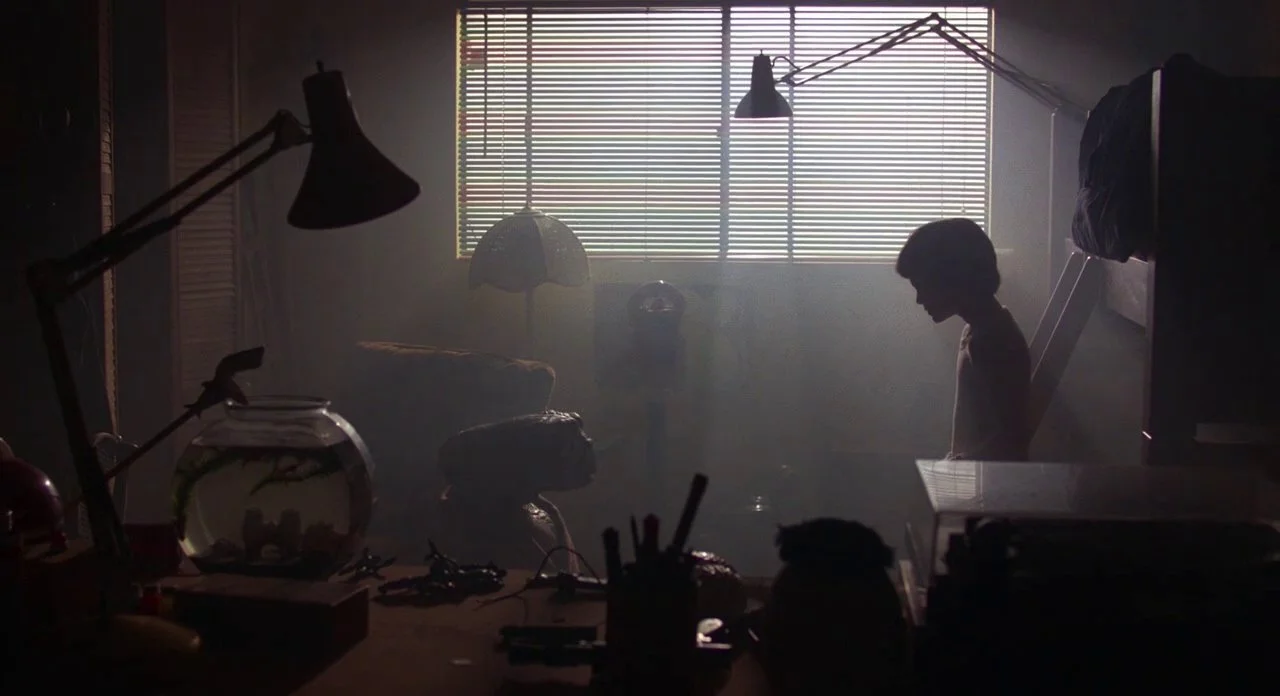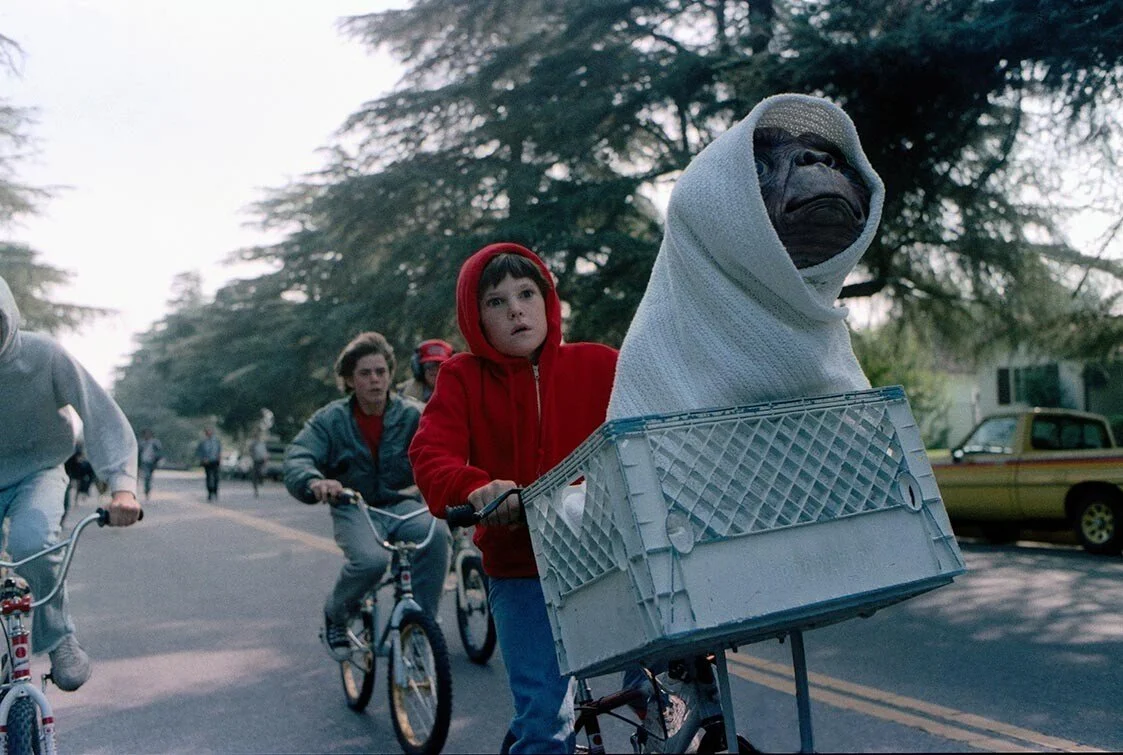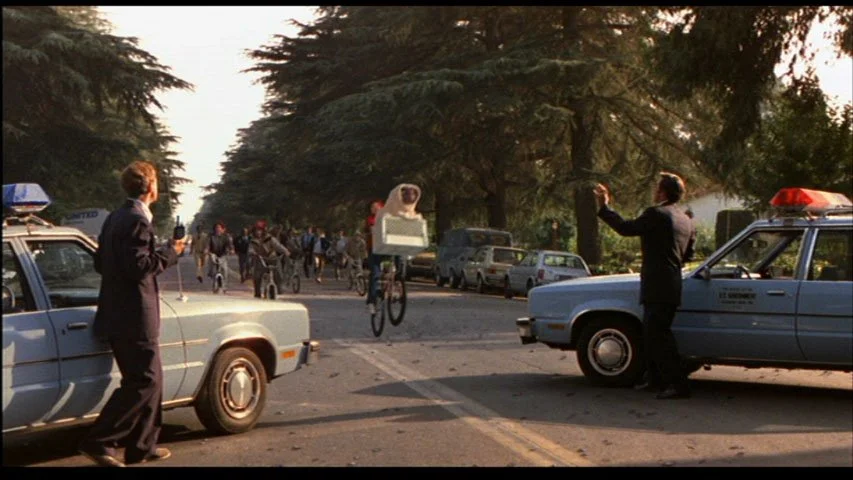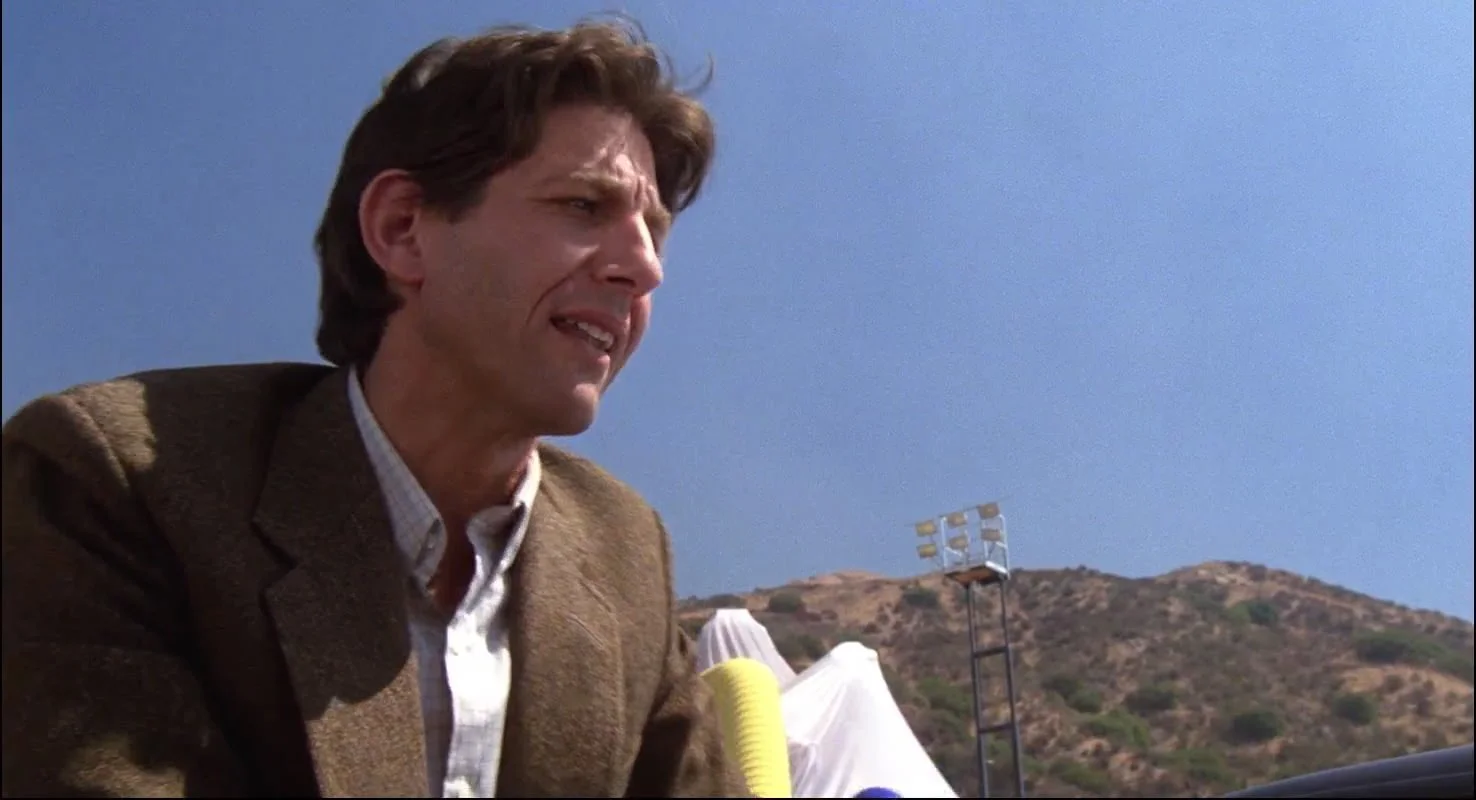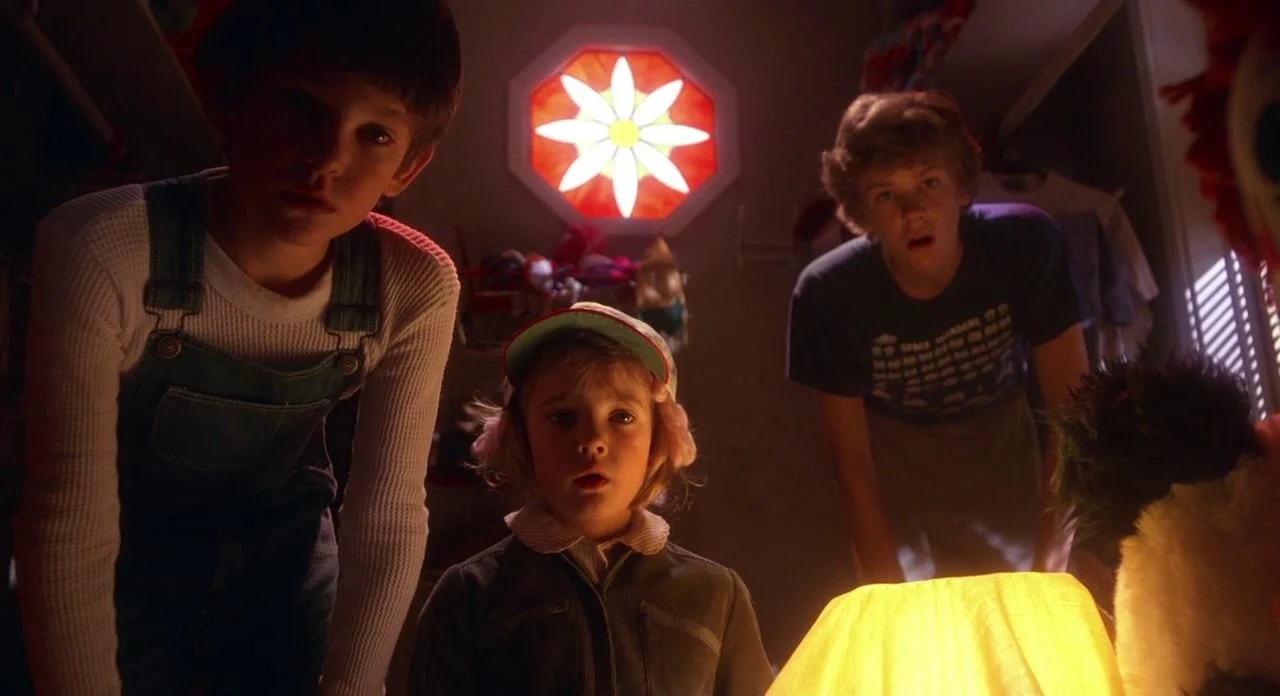E.T. and the Light in the Darkness: Spielberg Summer 2 Continues!
E.T. represents something of a fulcrum point for Steven Spielberg’s career.
Depending on who you talk to, his 1982 sci-fi fable is typically viewed as either:
the masterpiece that cemented Spielberg as a generational filmmaking talent, a movie unafraid to use unusual story elements as a vessel to reveal emotional vulnerability
the movie that exposed him as a storyteller not so much intuitive as manipulative, a creator brazen enough to do anything to get you to cry, even if it means dousing his film with a healthy dose of saccharin.
In my experience, there is an equal chance of E.T. THE EXTRA-TERRESTRIAL being your favorite Steven Spielberg movie as there is of it being the movie that made you swear him off forever. I truly know both types of people.
Regardless of which camp you reside in, though, it’s undeniable that E.T. was Spielberg’s legacy-maker; it was an overwhelming box-office success, smoking STAR WARS to become the then-highest-grossing film of all time, at over $350 million domestically and over $600 million worldwide. It snagged nine Academy Award nominations, including Best Picture and Best Director; it ended up winning four (Best Original Score, Best Sound Effects Editing, Best Sound, and Best Visual Effects). It helped boost the sales of Reese’s Pieces, turning it into the premier small round chocolate candy for at least a generation. It forever cemented phrases such as “phone home” into popular culture.
More than anything, it proved that, between this and RAIDERS OF THE LOST ARK, Steven Spielberg was here to stay. E.T. is an overwhelming success story. It’s also a movie that I’ve always kept at a little bit of a distance. It’s absolutely one that I watched quite a bit as a kid; it was almost impossible to miss. But when I think of my favorite Spielberg movies, poor E.T. doesn’t really come to mind at first. JAWS? RAIDERS? JURASSIC PARK? A couple of 2000’s outliers that we’ll discuss a couple of summers from now? Absolutely. But not E.T. It’s a movie that holds lots of great memories for me, but it’s never been a stone-cold favorite.
We’re going to try to unpack exactly why this week! Because there are a lot of tangible things about E.T. that made it a little difficult to fully embrace as a kid, although they’re the exact same things that make it sort of admirable now as an adult. But also…it’s genuinely hard for me to decide if the movie is fully sincere, or fully cynical. After my first rewatch of it as a fully forged adult, I’m still not 100% certain either way. It made for an interesting viewing, if nothing else!
E.T. THE EXTRA-TERRESTRIAL
Directed by: Steven Spielberg
Written by: Melissa Matheson
Starring: Henry Thomas, Robert MacNaughton, Dee Wallace, Drew Barrymore, Peter Coyote, C. Thomas Howell
Released: June 11, 1982
Length: 114 minutes
Even if you’ve managed to avoid it over the past four decades, you likely know the story of E.T. anyway: a visiting alien gets left behind by his family in their mad rush to avoid unwelcome government agents from descending on them. He ends up hiding in a Los Angeles suburb, in the backyard of a child named Elliot Taylor. Elliot quickly realizes he shares an emotional connection with the alien, who he names E.T. (an acronym for Extra-Terrestrial). He slowly recruits his family members to help him escape from the government, as well as get E.T. back home.
One of the most notable things about the movie is just how much of it is shot in shadow, especially during its first forty minutes. You expect this from the opening sequence, where E.T. gets lost in a forest while running for his life. But, once we move to the Taylor household, the shadows remain. His brother Michael conducts a D&D session in half-darkness. The Taylors eat their dinner in half-darkness. Elliot’s room is cast in half-darkness as he introduces E.T. to his action figures of Boba Fett. His sister Gertie hides in a closet consumed by darkness (I guess that one makes sense).
This is a very intentional choice; E.T. stumbles upon a household that has recently been decimated by a divorce that feels both very recent and very raw. Mary, their mother, falls to pieces after learning little details such as their father being in Mexico (“he hated Mexico”). Just the accidental evocation of the split by Elliot is enough for Michael to switch gears from making fun of him to genuinely being mad. This isn’t a family unit waiting to explode so much as one that is crumbling little by little. Why wouldn’t there be an ever-expanding darkness in the house?
Of course, this isn’t the kind of thing you actively pick up on as a kid, even if you yourself are a product of divorce. You can sort of grasp it as a story thing (“oh, Elliot’s sad because his dad is gone”), but you can’t really feel it until you’re an adult looking back, which is exactly what Spielberg was when he made E.T; his parents split when he was 19, which is such a weird, awkward time in your life for your mom and dad to get a divorce. Although broken families have been a theme and feature in Spielberg’s work going all the way back to DUEL, this was the first time he actively dealt with the emotional fallout of divorce.
But, I didn’t really clock any of that at eight. I just knew that E.T. made me sad. It was never so unbearable that I couldn’t ever watch it, and there was so much of it that I enjoyed; I loved the score, I loved the flashes of humor throughout (the top moment for me there was E.T. pretending to be a stuffed animal when Mom pops her head into the closet), I was weirdly fascinated by the design of E.T.; how he’s both grotesque and kinda adorable, a very very difficult trick to pull off. More than anything, I was taken by the genuine displays of emotions the movie was filled with. But it’s a movie that just kinda bummed me out. It’s a feeling that stuck with me so hard that I felt weirdly bummed out by incidental E.T.-related property. I remember going to Universal Studios one summer and going on the E.T. Adventure and getting a little moody watching the pre-show. I was just never as much in the mood to watch E.T. as I was, say, JURASSIC PARK or RAIDERS OF THE LOST ARK. So it goes.
But, the fact that it was able to evoke such a strong, foreign emotion as a child, the fact that the movie was sad, hopeful, bittersweet, even a little scary…I kinda love that upon reflection. Here’s a movie that basically set the bar for what a “family film” could be, and it never really condescends to its young audience. Melissa Matheson’s script assumes that the children in the theater will be able to handle themes like saying goodbye to loved ones, standing up for what’s right, other-ing things or people that are different than us. Spielberg assumes the children in the theater will be able to handle actors their age genuinely crying, or getting hurt, or being threatened by adults*.
*Or at least, he assumed at one point in time. More on that later.
Their assumptions appear to have been correct. Yeah, I just got done talking about how E.T. bummed me out. But that’s just my own personal reaction to its particular brand of sad whimsy. I wasn’t inconsolable. I wasn’t traumatized. I don’t know anybody who was genuinely hurt by E.T.* It was actually good for me to see movies that weren’t afraid to start putting into my mind some concepts that will eventually become realities as life started to truly commence. This all cuts against the way we tend to treat kids’ media now, with few exceptions: keep it bright, keep it light, put in some pop songs and celebrity voices, and nothing too scary, they’re just kids!
*Unless it was something like “E.T. himself scared me as a kid”, which I get, but is also a different thing.
Of course, the movie isn’t all sadness and darkness. Once E.T. fully enters the Taylors’ lives, and forges that literal connection with Elliot that causes one to feel the emotions of the other, the movie brightens up (again, intentional). There are some beautiful moments filmed in complete brightness, the most iconic one probably being all the bicyclists launching into the sky. My favorite on this rewatch, though, is the scene where Elliott gets drunk at school (thanks to E.T. discovering the power of beer when home alone). Once he pushes through the phase where he’s falling asleep in class, he reaches a state of irrational bravery. He can’t bring himself to chloroform the living frog they’ve been given to dissect, so he releases his, along with every other frog in the classroom. As E.T. watches John Wayne kiss Maureen O’Hara in THE QUIET MAN, Elliot pulls the same confident move to his crush in class, a striking moment of romance in a movie that doesn’t dabble in that emotional realm much otherwise.
(We also get my favorite shot in the whole movie here: the slow scrolling shot of a girl frozen in fear in the middle of the classroom, holding two renegade frogs.)
There are some elements of E.T. that give me a little pause. Like, I’ve never really known what to make of the Jesus metaphor at the center of it all, the fact that E.T. literally dies and gets resurrected, the fact that (as Spielberg biographer Joseph McBride points out) the film’s poster is literally evoking The Creation of Adam. This is all very odd (allegedly unintentional!) imagery coming from a director who would very soon be dealing directly with his Jewishness in his work. Look, I’m not the one to unpack any of this; as I explained in a previous iteration of this blog, when I broke down THE LAST TEMPTATION OF CHRIST, I’m not exactly a practicing Catholic, nor am I remotely Jewish, so I’m not exactly offended by this possibly unintentional framework. But…E.T. has always read to me as this lost puppy dog, full of love and wonder, showing up to a household suffering a severe lack of both. So, when he rises from the dead and there’s this implication that maybe this puppy dog is also Christ, it always throws me. I don’t know what to do with this. That’s all.
Also, it’s hard to be from a certain generation (millennials) and not associate E.T. THE EXTRA-TERRESTRIAL with one of the odder directors’ cuts of the 21st century. For those who weren’t there: in honor of the movie’s 20th birthday, Spielberg concocted a revised edition of the film to run in theaters. It was a big deal! It had its own premiere and everything. In some ways, the changes ended up being minor: a touched-up special effect here, a re-introduced scene there. A reference to a Halloween costume is changed from “terrorist” to “hippie”, which seems arbitrary, but 9/11 had happened less than a year ago at that point, so chalk it up to a product of its time.
In some ways, though, the changes neutered the very nature of the film. The amendment that gained the highest profile was the decision to remove the guns from the hands of federal agents at the end and replace them with walkie-talkies, presumably to remove the very violent implied threat: that these grown men would shoot kids if duty demanded it. It’s not easy to source down a contemporary justification for this, but Spielberg has stated that complaints of parents groups at the time weighed on him over the years. It’s also not hard to assume that this change of heart was a product of the more “responsible” Spielberg that would begin emerging as the 80s marched on. Kids are vulnerable in so many ways now; why threaten them with guns onscreen as well?
For those younger than me, it may be difficult (or literally impossible) to remember, but there was a very real debate being had at the end of the 20th century that boiled over into the beginning of the next: how much autonomy does an artist have once their art is released to the public? It’s probably a conversation that goes back several centuries, but it only became serious business to us once it got filtered through the only art we ever seem to care about: the original STAR WARS trilogy. In honor of that movie’s 20th anniversary, Spielberg’s buddy George Lucas started revising and revamping his magnum opus, replacing subpar special effects with modern ones, and inserting new scenes that he wished he had retained (such as that really horrible-looking Jabba the Hutt scene in A NEW HOPE.
This, of course, missed the point of why we return to older movies in the first place: the escape from the now. I have my doubts that anybody has ever sincerely wished movies from the past could be updated to look like the present, but even if they did, it wouldn’t be a wish worth granting. Lucas’ reputation began to erode after all this,* especially when it made it clear that these were now the definitive version of STAR WARS now. Yes, younglings who now only know Lucas as this revered hermetic figure, there was once a very real hatred towards this guy for a very long time, a fire that was only accelerated once the prequel trilogy dropped and everyone hated it.
*It should be noted, though, that these Special Editions made a fucking mint during their theatrical runs. Lucas basically dared us to do something about it, and we responded by giving him money. Who’s the joke on?
Anyway, it should go without saying that removing some of the danger the kids face in E.T. removes part of the film’s thematic richness. The world is dangerous and a little scary, and adults don’t always have kids’ best intentions in mind. Sanding off some of the movie’s edges removes an equal amount of its power. More to the point…of all the things in E.T. that unnerved me as a kid, the presence of guns wasn’t one of them. I never even really thought about it.
A pair of positive footnotes to all of this: to his immense credit, Spielberg expressed regret about the Special Edition almost immediately: the DVD release contained both versions of the film and he has never gone back to alter any of his work ever again. Also, the Special Edition of E.T. is very hard to track down now; the original version is the default one you’ll see if you buy the movie on physical media or streaming, putting Spielberg in stark contrast with his friend George Lucas. It does seem like Spielberg learned something about himself in the aftermath of this unforced error, and you have to genuinely give him credit for that.
The last thing I wanted to mention about E.T. THE EXTRA-TERRESTRIAL before I close out: the performances are almost uniformly stellar. Of the adults, Peter Coyote’s “Keys” was the standout for me, elevating a character that really is barebones on the page (his name is only generated from the constantly-jangling “keys” on his belt, giving him the impression of an Old West villain) and turning him into…well, neither a good or bad guy, necessarily. He really does try to save E.T., and tries to be as kind as possible to Elliott once he fails to (Keys himself was once a young boy who believed in aliens). However, he ultimately can’t help but be accidentally destructive in the way only adults can be (much like Elliott’s unseen father).
Of the kid actors, the three central ones are shockingly good, and two of them tend to get all the ink; Drew Barrymore was a fucking natural in front of the camera at the age of seven, and Henry Thomas carries this entire movie on his shoulders. His role is immense; if we don’t believe Elliot’s emotions at every turn, the movie could easily have collapsed, and felt a lot sillier than it ends up being. But the one who I think gets forgotten about a little bit is Robert MacNaughton. Maybe it’s because he’s the most obscure name of the three; as a result of him retiring from acting in 2002, his filmography is sparse*. But his portrayal of Michael really stuck with me on this rewatch. Yes, he does a great job in the earlier sequences, when he plays that needling, teasing older-brother role (he really is being kind of a penis-breath). But he’s arguably even stronger when he buys into the reality of E.T. the alien, and becomes Elliot’s primary collaborator to get him home. Maybe it’s because he’s such a pain to Elliot in the beginning, and such a disbeliever that anything was out there, that it hits so much harder when you see his eventual devastation at E.T.'s apparent death.
*He did return to the business to do two movies in 2015.
So, there’s much to love about E.T. THE EXTRA-TERRESTRIAL, even if it’s never quite been this overwhelming masterpiece for me, at least in comparison to other Spielberg joints. I just don’t have quite the same emotional connection to it that others do (barring that aforementioned sense of forlornness). The famous ending scene (where E.T. points to Elliot’s forehead and says “I’ll be right here”) never really makes me sad or happy, I just sort of sit there and appreciate the solid mechanics of it all. And maybe that’s the thing that holds it back juuust far enough from being a five-star experience? I’m focusing too much on how the movie is trying to make you feel things at key moments, instead of just feeling them? Although I heavily disagree with the characterization of Spielberg as an emotional manipulator, there were moments in this rewatch that made me at least understand where people were coming from on that stance.
Still, at least we’ve kept access to a version of the movie that remains a little sad and a little scary, and is still unafraid to let a generation of kids know that, yeah, sometimes adults fuck up, and you’re going to be left to carry that burden a little bit. But, even in a world of darkness, light can come when you least expect it, and that brief light may eventually extinguish, but the memories of it will be enough to help see you through anyway.
And what else do you need to cement a legacy?
